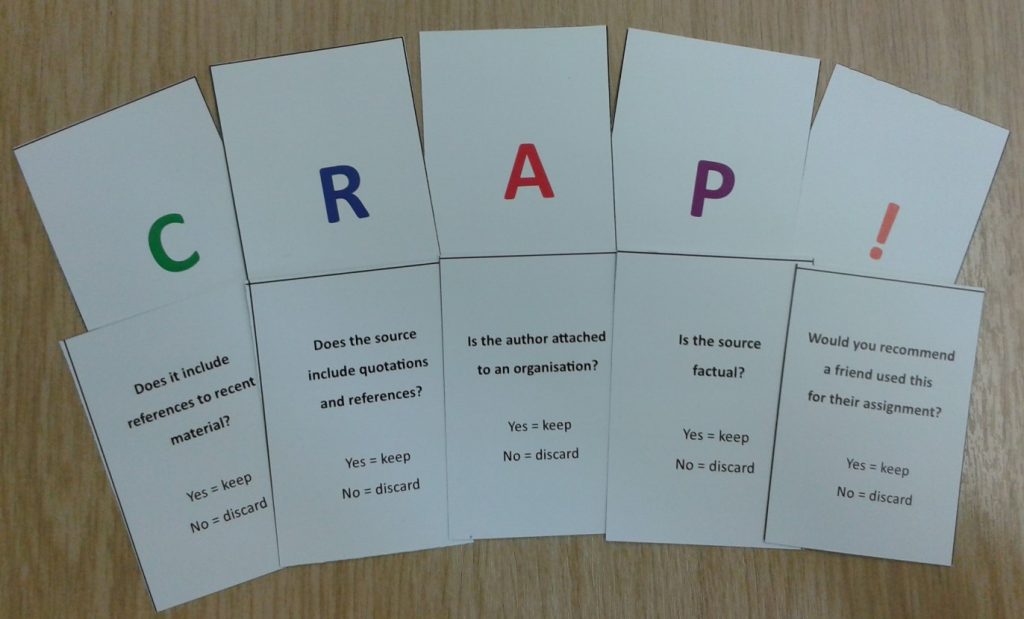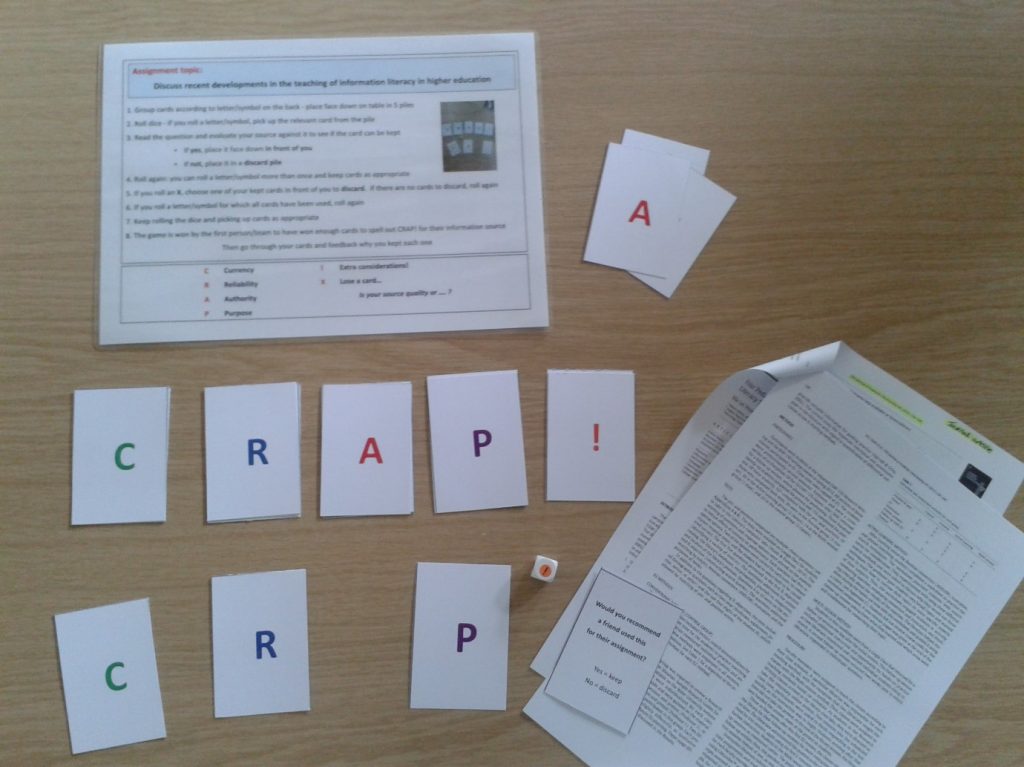Kathryn Ballard, Information Librarian at Southampton Solent University, introduces a game that she has designed to encourage participants to evaluate information sources. The CRAP! Game was a runner-up at LILAC 2016‘s popular Lagadothon event.
UPDATE 25/11/16: Professionally designed versions of the CRAP! Game cards are now available for you to download and use.
LILAC 2016 brought with it the inaugural Lagadothon – a showcase of new information literacy games and products ready for testing by delegates. I was invited to present the CRAP! Game – a card and dice game encouraging participants to evaluate information sources against a range of quality criteria.
The Lagadothon itself was great fun, with six presenters vying for the top prize of £500 towards developing their product. We each presented our game to multiple groups of players in turn, then they and the judges decided on the winners…
The CRAP! Game is something that I developed after a training event with Andrew Walsh. It can be played by several individuals or they can compete in small groups. It uses a set of cards and a dice to drive the game, with each player/group also being given a different information source to work with. It uses the CRAP (Currency, Reliability, Authority, Purpose) acronym as a quick and potentially amusing way to encourage players to remember quality criteria to apply to sources.
To play, five piles of cards are placed face down on the table in front of each player, grouped according to the letter or symbol on the back of the card: C, R, A, P, ! There are four cards for each group, and each has a different question relating to that group’s criteria (so a card marked C will have a question about currency, for example).

The dice has sides marked with C, R, A, P, !, X. Players roll the dice and pick up a card from the pile indicated. They then evaluate their information source against the question on that card. They can keep or discard the card depending on their answer. Kept cards are placed face down in front of the player, and they can build up piles of cards from the same category. Rolling the X means they have to return one of their ‘won’ cards to the discard pile. The winner is the first to spell out CRAP! for their source by being able to give a positive answer to at least one question from each of the criteria. Their ability to do this will depend on how nicely the dice rolls work out for them – but also on the type of source they have been given, as some may fit the criteria more readily than others.

The winner of the game has to feedback as to why they kept their cards and the class facilitator can help the group discuss this. This should help to back up understanding of the issues around evaluation and quality of sources. It is also a good opportunity to point out to students that if they weren’t able to spell out CRAP! for their source, it is not their fault that it didn’t work! It is down to the source itself and they did the right thing by evaluating it properly.
By going through this process, the players would hopefully remember the criteria with which they can evaluate the information sources they use for their research. They would also become aware that some sources may be seen as more academically appropriate than others.
The questions on the cards are generic and so can be used across different subject areas. The sources used could be tailored to a specific subject area and so offer an element of customisation. Each player or group will need one pack of cards, one dice and one information source – so a class of 20 playing in pairs would need 10 packs of cards, 10 dice and 10 different information sources.
After showing the game at the Lagadothon, I was very pleased to be awarded a runner’s up prize and to get some really useful feedback from the judges. It was great to see the ideas that other presenters had come up with, and to see all the participants enjoying an hour of combining information literacy and playing – surely librarians’ two favourite things? I will be using the prize money to get the cards designed professionally. The cards themselves (and instructions) will be freely available to anyone else who may wish to have a go at introducing the CRAP! Game within their own institution. The dice can made by buying some plain dice and labelling with sticky dots and a marker pen (I promise it doesn’t take too long to do…)!
If you would like to find out more about Kathryn’s innovative idea, you can contact her at kathryn.ballard@solent.ac.uk
UPDATE 25/11/16: Professionally designed versions of the CRAP! Game cards are now available for you to download and use. These resources, created by Elliot Croft and Kathryn Ballard, have been made available under a BY-NC-SA Creative Commons licence:
Escape rooms for learning: the LILAC Lagadothon 2016 winner
Find out more about the entries to the LILAC Lagadothon 2016 event
